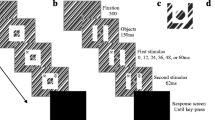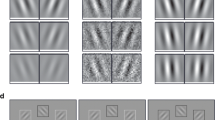Abstract
The aim of this research was to study the relationship between perceptual judgments about space and time. If spatial and temporal judgments were dissociable, they should be modulated selectively by attention. We compared the effect of the attentional set upon fine-grained spatial versus temporal discrimination of visual perception in two experiments. Using identical sensory stimulation, we measured perceptual judgments on either the size of a small spatial gap or the duration of a brief temporal gap. The attentional set was manipulated by cuing the task that was most likely to be performed. In one experiment, a neutral cue was also used, to measure relative benefits and costs of spatial and temporal task sets. If the attentional set could be directed selectively to spatial and temporal task-relevant dimensions, performance on both spatial and temporal acuity tasks should be specifically modulated by task cuing. The results showed that the attentional set enhanced the speed and accuracy of perceptual judgments similarly on both spatial and temporal tasks. Moreover, accuracy in one task was selectively enhanced by attending to that task while remaining unaffected by attending to the alternative task. This finding suggests multiple mechanisms, by which visual processing of spatial and temporal features can be selectively prepared without interfering with one another.



Similar content being viewed by others
References
Boltz MG (1998) The processing of temporal and nontemporal information in the remembering of event durations and musical structure. J Exp Psychol Hum Percept Perform 24:1087–1104
Brown SW (1997) Attentional resources in timing: interference effects in concurrent temporal and nontemporal working memory tasks. Percept Psychophys 59:1118–1140
Brown SW (2006) Timing and executive function: bidirectional interference between concurrent temporal production and randomization tasks. Mem Cognit 34:1464–1471
Casasanto D, Boroditsky L (2008) Time in the mind: using space to think about time. Cognition 106:579–593
Coull JT, Vidal F, Nazarian B, Macar F (2004) Functional anatomy of the attentional modulation of time estimation. Science 303:1506–1508
Fraisse P (1984) Perception and estimation of time. Annu Rev Psychol 35:1–37
Grondin S, Macar F (1992) Dividing attention between temporal and nontemporal tasks: a performance operating characteristic—POC—analysis. In: Macar F, Pouthas V, Friedman W (eds) Time, action, cognition: towards bridging the gap. Kluwer, Dordrecht, pp 119–128
Halbig TD, Mecklinger A, Schriefers H, Friederici AD (1998) Double dissociation of processing temporal and spatial information in working memory. Neuropsychologia 36:305–311
Jones B, Huang YL (1982) Space–time dependencies in psychological judgment of extent and duration: Algebraic model of the tau and kappa effects. Psychol Bull 91:128–142
Sarrazin JC, Giraudo MD, Pailhous J, Bootsma RJ, Giraudo MD (2004) Dynamics of balancing space and time in memory: tau and kappa effects revisited. J Exp Psychol Hum Percept Perform 30:411–430
Schubotz RI, von Cramon DY (2001) Functional organization of the lateral premotor cortex: fMRI reveals different regions activated by anticipation of object properties, location and speed. Cogn Brain Res 11:97–112
Schubotz RI, von Cramon DY, Lohmann G (2003) Auditory what, where, and when: a sensory somatotopy in lateral premotor cortex. Neuroimage 20:173–185
Thomas EAC, Cantor NE (1975) On the duality of simultaneous time and size perception. Percept Psychophys 18:44–48
Walsh V (2003) A theory of magnitude: common cortical metrics of time, space and quantity. Trends Cogn Sci 7:483–488
Zakay D (1998) Attention allocation policy influences prospective timing. Psychon Bull Rev 5:114–118
Zakay D, Block RA (1996) The role of attention in time estimation processes. In: Pastor MA, Artieda J (eds) Time, internal clocks and movement. Elsevier, Amsterdam, pp 143–163
Acknowledgments
This research was supported by the Spanish Ministerio de Educación y Cultura with a postdoctoral grant (EX-2005-1028) to A.C. and by an award from the James S. McDonnell Foundation to A.C.N.
Author information
Authors and Affiliations
Corresponding author
Rights and permissions
About this article
Cite this article
Correa, Á., Nobre, A.C. Spatial and temporal acuity of visual perception can be enhanced selectively by attentional set. Exp Brain Res 189, 339–344 (2008). https://doi.org/10.1007/s00221-008-1429-2
Received:
Accepted:
Published:
Issue Date:
DOI: https://doi.org/10.1007/s00221-008-1429-2




